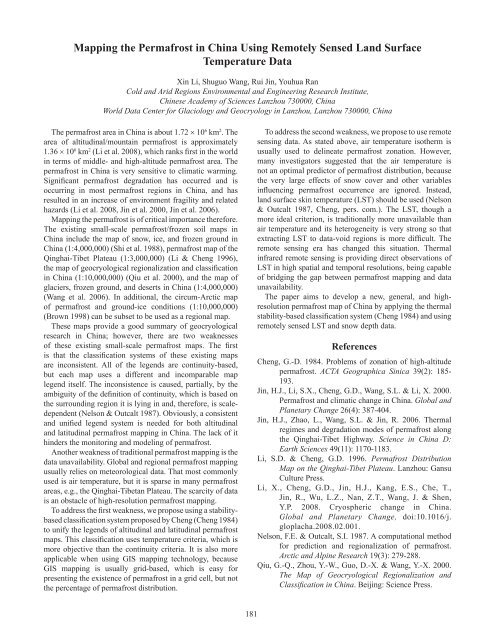Ninth International Conference on Permafrost ... - IARC Research
Ninth International Conference on Permafrost ... - IARC Research
Ninth International Conference on Permafrost ... - IARC Research
You also want an ePaper? Increase the reach of your titles
YUMPU automatically turns print PDFs into web optimized ePapers that Google loves.
Mapping the <strong>Permafrost</strong> in China Using Remotely Sensed Land SurfaceTemperature DataXin Li, Shuguo Wang, Rui Jin, Youhua RanCold and Arid Regi<strong>on</strong>s Envir<strong>on</strong>mental and Engineering <strong>Research</strong> Institute,Chinese Academy of Sciences Lanzhou 730000, ChinaWorld Data Center for Glaciology and Geocryology in Lanzhou, Lanzhou 730000, ChinaThe permafrost area in China is about 1.72 × 10 6 km 2 . Thearea of altitudinal/mountain permafrost is approximately1.36 × 10 6 km 2 (Li et al. 2008), which ranks first in the worldin terms of middle- and high-altitude permafrost area. Thepermafrost in China is very sensitive to climatic warming.Significant permafrost degradati<strong>on</strong> has occurred and isoccurring in most permafrost regi<strong>on</strong>s in China, and hasresulted in an increase of envir<strong>on</strong>ment fragility and relatedhazards (Li et al. 2008, Jin et al. 2000, Jin et al. 2006).Mapping the permafrost is of critical importance therefore.The existing small-scale permafrost/frozen soil maps inChina include the map of snow, ice, and frozen ground inChina (1:4,000,000) (Shi et al. 1988), permafrost map of theQinghai-Tibet Plateau (1:3,000,000) (Li & Cheng 1996),the map of geocryological regi<strong>on</strong>alizati<strong>on</strong> and classificati<strong>on</strong>in China (1:10,000,000) (Qiu et al. 2000), and the map ofglaciers, frozen ground, and deserts in China (1:4,000,000)(Wang et al. 2006). In additi<strong>on</strong>al, the circum-Arctic mapof permafrost and ground-ice c<strong>on</strong>diti<strong>on</strong>s (1:10,000,000)(Brown 1998) can be subset to be used as a regi<strong>on</strong>al map.These maps provide a good summary of geocryologicalresearch in China; however, there are two weaknessesof these existing small-scale permafrost maps. The firstis that the classificati<strong>on</strong> systems of these existing mapsare inc<strong>on</strong>sistent. All of the legends are c<strong>on</strong>tinuity-based,but each map uses a different and incomparable maplegend itself. The inc<strong>on</strong>sistence is caused, partially, by theambiguity of the definiti<strong>on</strong> of c<strong>on</strong>tinuity, which is based <strong>on</strong>the surrounding regi<strong>on</strong> it is lying in and, therefore, is scaledependent(Nels<strong>on</strong> & Outcalt 1987). Obviously, a c<strong>on</strong>sistentand unified legend system is needed for both altitudinaland latitudinal permafrost mapping in China. The lack of ithinders the m<strong>on</strong>itoring and modeling of permafrost.Another weakness of traditi<strong>on</strong>al permafrost mapping is thedata unavailability. Global and regi<strong>on</strong>al permafrost mappingusually relies <strong>on</strong> meteorological data. That most comm<strong>on</strong>lyused is air temperature, but it is sparse in many permafrostareas, e.g., the Qinghai-Tibetan Plateau. The scarcity of datais an obstacle of high-resoluti<strong>on</strong> permafrost mapping.To address the first weakness, we propose using a stabilitybasedclassificati<strong>on</strong> system proposed by Cheng (Cheng 1984)to unify the legends of altitudinal and latitudinal permafrostmaps. This classificati<strong>on</strong> uses temperature criteria, which ismore objective than the c<strong>on</strong>tinuity criteria. It is also moreapplicable when using GIS mapping technology, becauseGIS mapping is usually grid-based, which is easy forpresenting the existence of permafrost in a grid cell, but notthe percentage of permafrost distributi<strong>on</strong>.To address the sec<strong>on</strong>d weakness, we propose to use remotesensing data. As stated above, air temperature isotherm isusually used to delineate permafrost z<strong>on</strong>ati<strong>on</strong>. However,many investigators suggested that the air temperature isnot an optimal predictor of permafrost distributi<strong>on</strong>, becausethe very large effects of snow cover and other variablesinfluencing permafrost occurrence are ignored. Instead,land surface skin temperature (LST) should be used (Nels<strong>on</strong>& Outcalt 1987, Cheng, pers. com.). The LST, though amore ideal criteri<strong>on</strong>, is traditi<strong>on</strong>ally more unavailable thanair temperature and its heterogeneity is very str<strong>on</strong>g so thatextracting LST to data-void regi<strong>on</strong>s is more difficult. Theremote sensing era has changed this situati<strong>on</strong>. Thermalinfrared remote sensing is providing direct observati<strong>on</strong>s ofLST in high spatial and temporal resoluti<strong>on</strong>s, being capableof bridging the gap between permafrost mapping and dataunavailability.The paper aims to develop a new, general, and highresoluti<strong>on</strong>permafrost map of China by applying the thermalstability-based classificati<strong>on</strong> system (Cheng 1984) and usingremotely sensed LST and snow depth data.ReferencesCheng, G.-D. 1984. Problems of z<strong>on</strong>ati<strong>on</strong> of high-altitudepermafrost. ACTA Geographica Sinica 39(2): 185-193.Jin, H.J., Li, S.X., Cheng, G.D., Wang, S.L. & Li, X. 2000.<strong>Permafrost</strong> and climatic change in China. Global andPlanetary Change 26(4): 387-404.Jin, H.J., Zhao, L., Wang, S.L. & Jin, R. 2006. Thermalregimes and degradati<strong>on</strong> modes of permafrost al<strong>on</strong>gthe Qinghai-Tibet Highway. Science in China D:Earth Sciences 49(11): 1170-1183.Li, S.D. & Cheng, G.D. 1996. <strong>Permafrost</strong> Distributi<strong>on</strong>Map <strong>on</strong> the Qinghai-Tibet Plateau. Lanzhou: GansuCulture Press.Li, X., Cheng, G.D., Jin, H.J., Kang, E.S., Che, T.,Jin, R., Wu, L.Z., Nan, Z.T., Wang, J. & Shen,Y.P. 2008. Cryospheric change in China.Global and Planetary Change, doi:10.1016/j.gloplacha.2008.02.001.Nels<strong>on</strong>, F.E. & Outcalt, S.I. 1987. A computati<strong>on</strong>al methodfor predicti<strong>on</strong> and regi<strong>on</strong>alizati<strong>on</strong> of permafrost.Arctic and Alpine <strong>Research</strong> 19(3): 279-288.Qiu, G.-Q., Zhou, Y.-W., Guo, D.-X. & Wang, Y.-X. 2000.The Map of Geocryological Regi<strong>on</strong>alizati<strong>on</strong> andClassificati<strong>on</strong> in China. Beijing: Science Press.181
















